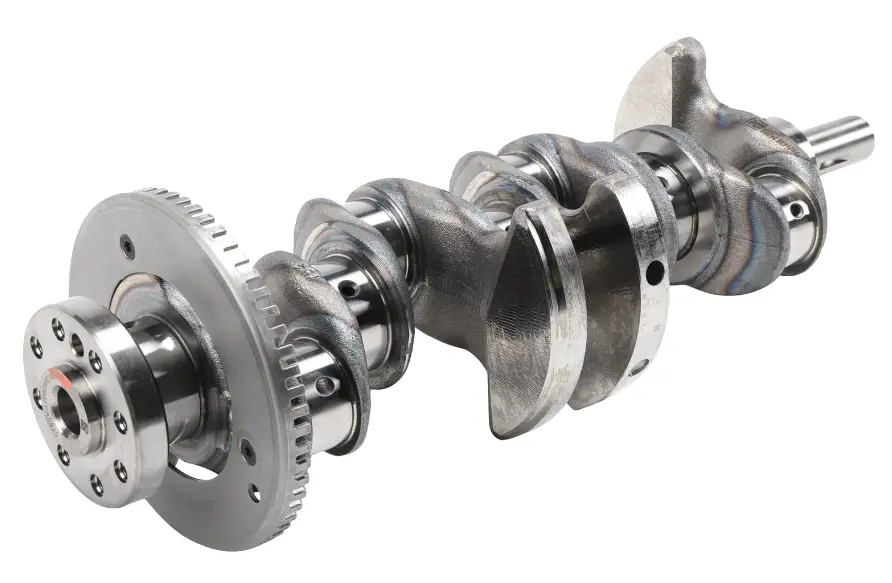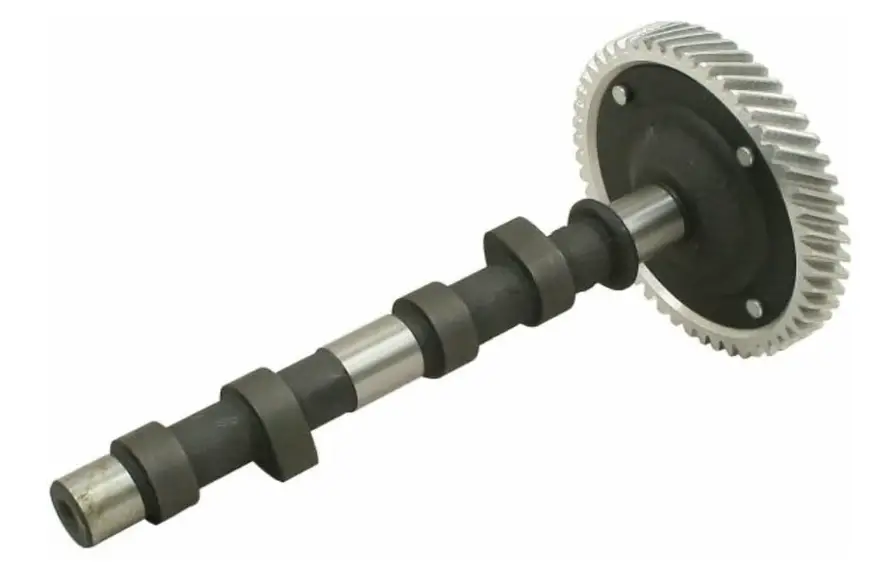In a typical four-stroke engine, the camshaft rotates at half the speed of the crankshaft. This 2:1 ratio ensures that the intake and exhaust valves controlled by the camshaft open and close once for every two revolutions of the crankshaft, aligning with the engine’s four-stroke cycle. Proper synchronization between these components is essential for efficient engine performance and preventing damage.
When discussing internal combustion engines, particularly those found in cars and trucks, the terms “crankshaft” and “camshaft” frequently arise. These two components are vital to the engine’s operation, but they perform distinct functions and operate at different speeds. Understanding the relationship between crankshaft and camshaft speed is crucial for anyone interested in automotive mechanics, engine performance, or vehicle maintenance.
Contents
Crankshaft and Camshaft
Before diving into the specifics of speed differences, it’s essential to understand what the crankshaft and camshaft are and what they do.
- Crankshaft: The crankshaft is a long, rotating shaft that converts the linear motion of the pistons into rotational motion, which then drives the wheels of the vehicle. It is connected to the pistons via connecting rods and is responsible for turning the engine’s flywheel.
- Camshaft: The camshaft controls the opening and closing of the engine’s intake and exhaust valves. It does so through cam lobes (raised sections on the camshaft), which push on the valve lifters, opening the valves at precise times during the engine’s operation.

Speed Differences: Why They Matter
One of the fundamental differences between the crankshaft and camshaft is their operating speed. In a typical four-stroke internal combustion engine, the crankshaft and camshaft do not rotate at the same speed. The camshaft operates at half the speed of the crankshaft. Understanding why this occurs requires a closer look at the engine cycle.
- The Four-Stroke Cycle:
- Intake Stroke: The intake valve opens, and the piston moves down, drawing air-fuel mixture into the cylinder.
- Compression Stroke: The intake valve closes, and the piston moves up, compressing the mixture.
- Power Stroke: The spark plug ignites the compressed mixture, forcing the piston down.
- Exhaust Stroke: The exhaust valve opens, and the piston moves up, expelling the burned gases.
In a four-stroke engine, the crankshaft must complete two full revolutions (720 degrees of rotation) to complete one engine cycle. During this cycle, the camshaft only completes one full revolution (360 degrees). This means the camshaft turns at half the speed of the crankshaft. The reason for this is that the camshaft only needs to open the intake and exhaust valves once for every two revolutions of the crankshaft.
Mechanism Behind the Speed Difference
The speed relationship between the crankshaft and camshaft is typically achieved through a timing belt or chain that connects the two. The timing belt/chain has a specific ratio of teeth on the crankshaft sprocket to the camshaft sprocket, usually 2:1. This ratio ensures that for every two turns of the crankshaft, the camshaft turns once.
In some engines, gears or even direct drive systems are used instead of belts or chains, but the principle remains the same: the camshaft must rotate at half the speed of the crankshaft to maintain proper valve timing.
Importance of Timing
The timing of the camshaft in relation to the crankshaft is critical for engine performance. If the camshaft and crankshaft are not synchronized correctly, the engine may experience issues such as:
- Poor Performance: Incorrect valve timing can lead to reduced engine power and efficiency.
- Engine Misfires: Valves that open or close at the wrong time can cause misfires, where the fuel-air mixture doesn’t combust properly.
- Potential Engine Damage: Severe timing issues can result in valve-piston collisions, leading to catastrophic engine failure.
This is why timing belts and timing chains are critical components that require regular maintenance. A worn or broken timing belt/chain can lead to significant engine damage if it causes the camshaft and crankshaft to lose synchronization.
Impact on Engine Design
The 2:1 speed ratio between the crankshaft and camshaft has a direct impact on engine design and performance. Engineers must carefully design the camshaft profile (the shape of the cam lobes) to ensure that the valves open and close at the optimal times. This involves considering factors such as:
- Valve Lift: How far the valve opens, affecting the amount of air/fuel mixture entering the cylinder.
- Valve Duration: How long the valve stays open, which influences the engine’s power and efficiency.
- Valve Overlap: The period during which both the intake and exhaust valves are open, which can affect engine scavenging (the removal of exhaust gases).
These factors must be precisely calculated, and the camshaft profile must be machined with high precision to ensure that the engine runs smoothly and efficiently.
Variable Valve Timing (VVT)
Modern engines often use Variable Valve Timing (VVT) systems to optimize engine performance across a wider range of conditions. VVT systems can alter the timing of the camshaft relative to the crankshaft, changing when the valves open and close. This can improve fuel efficiency, increase power output, and reduce emissions.
VVT systems highlight the importance of the relationship between crankshaft and camshaft speeds. By allowing the camshaft to operate at slightly different speeds or positions relative to the crankshaft, engineers can fine-tune engine performance for various driving conditions.
Common Issues and Maintenance Tips
Given the critical nature of the timing relationship between the crankshaft and camshaft, it’s essential to be aware of potential issues and maintenance tips:
- Timing Belt/Chain Wear: Over time, timing belts and chains can stretch or wear out, leading to a loss of synchronization between the crankshaft and camshaft. Regular inspection and replacement (typically every 60,000 to 100,000 miles) can prevent this issue.
- Tensioner Problems: The timing belt/chain tensioner ensures that the belt/chain remains taut. A faulty tensioner can cause slack, leading to timing issues.
- Misalignment: Improper installation of the timing belt/chain or camshaft can lead to misalignment. Ensure that any repairs or replacements are done by qualified technicians.
- Noise: Unusual noises from the engine, such as rattling or ticking, may indicate timing belt/chain issues or camshaft problems. These should be investigated promptly to avoid more severe damage.
- Check Engine Light: In modern vehicles, the check engine light may illuminate if there is a problem with the timing system. This could indicate a misalignment between the crankshaft and camshaft, among other issues.

Frequently Asked Questions
Here are some FAQs about the difference between crankshaft and camshaft speed –
1. Why does the camshaft rotate at half the speed of the crankshaft?
The camshaft rotates at half the speed of the crankshaft because it needs to open and close the intake and exhaust valves only once for every two revolutions of the crankshaft in a four-stroke engine. This synchronization ensures that the valves operate at the correct times during the engine cycle.
2. What happens if the camshaft and crankshaft are not synchronized?
If the camshaft and crankshaft are not synchronized, the engine may experience poor performance, misfires, or even catastrophic damage. Incorrect timing can lead to valves opening or closing at the wrong times, potentially causing them to collide with the pistons.
3. How can I tell if my timing belt or chain needs to be replaced?
Common signs that a timing belt or chain needs replacement include unusual engine noises (such as rattling or ticking), difficulty starting the engine, and the check engine light illuminating. Regular maintenance and inspections according to the manufacturer’s recommendations are the best way to prevent timing issues.
4. What is Variable Valve Timing (VVT), and how does it affect camshaft speed?
Variable Valve Timing (VVT) is a system that adjusts the timing of the camshaft relative to the crankshaft, optimizing valve operation for different engine conditions. While VVT doesn’t change the basic speed ratio between the camshaft and crankshaft, it allows the camshaft’s position to vary slightly to improve performance, efficiency, and emissions.
5. Can a timing chain/belt cause engine damage if it fails?
Yes, if a timing chain or belt fails, it can cause severe engine damage. In interference engines, where the valves and pistons share the same space, a failed timing chain or belt can lead to the valves colliding with the pistons, resulting in bent valves, damaged pistons, and potentially a ruined engine.
Conclusion
In conclusion, while both the crankshaft and camshaft are crucial components in an engine’s operation, their speeds are fundamentally different due to their distinct roles in the engine cycle. The crankshaft rotates at a speed directly proportional to the engine’s RPM (revolutions per minute), while the camshaft, responsible for controlling the timing of the intake and exhaust valves, typically rotates at half the speed of the crankshaft in a four-stroke engine.
This relationship is essential for maintaining proper engine timing and ensuring optimal performance. Understanding the differences in their speeds is key for anyone looking to gain deeper insights into engine mechanics.